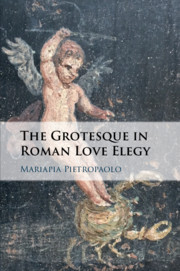Book contents
- The Grotesque in Roman Love Elegy
- The Grotesque in Roman Love Elegy
- Copyright page
- Dedication
- Contents
- Preface
- Acknowledgements
- Abbreviations
- Chapter 1 Premises and Expectations of the Elegiac Grotesque
- Chapter 2 Context and Prehistory of the Elegiac Grotesque
- Chapter 3 Cynthia and the Grotesque Ethos
- Chapter 4 The Ovidian Unmasking of the Elegiac Grotesque
- Chapter 5 Revolting and Refined: The Aesthetic Function of Acanthis
- Chapter 6 Grotesque Hermeneutics of the Lena in Tibullus and Ovid
- Chapter 7 The Rival: A Vir Foedus
- Chapter 8 Pasiphae and the Allurement of the Grotesque
- Chapter 9 Ovid’s Remedia and the Waning of the Elegiac Grotesque
- References
- Index
Chapter 2 - Context and Prehistory of the Elegiac Grotesque
Published online by Cambridge University Press: 10 September 2020
- The Grotesque in Roman Love Elegy
- The Grotesque in Roman Love Elegy
- Copyright page
- Dedication
- Contents
- Preface
- Acknowledgements
- Abbreviations
- Chapter 1 Premises and Expectations of the Elegiac Grotesque
- Chapter 2 Context and Prehistory of the Elegiac Grotesque
- Chapter 3 Cynthia and the Grotesque Ethos
- Chapter 4 The Ovidian Unmasking of the Elegiac Grotesque
- Chapter 5 Revolting and Refined: The Aesthetic Function of Acanthis
- Chapter 6 Grotesque Hermeneutics of the Lena in Tibullus and Ovid
- Chapter 7 The Rival: A Vir Foedus
- Chapter 8 Pasiphae and the Allurement of the Grotesque
- Chapter 9 Ovid’s Remedia and the Waning of the Elegiac Grotesque
- References
- Index
Summary
The primary purpose of this chapter is to show that, in the philosophical and literary discourse that immediately preceded the development of Roman love elegy, there exists a context conducive to the grotesque figuration of the sublimity of love and lovers. In Roman culture the philosophical discourse was dominated by Lucretius, who developed his views in dialogue with the poetry and natural philosophy of the centuries that preceded him, especially in the expository genres that united poetry and philosophy. The literary discourse is focused on Catullus, whose use of metaphors as instances of material identification shock the reader with the violation of logic and the transgression of nature. In the elegiac libellus Catullus resorts frequently to such violations, extending them to the human body, to social conduct, and to love itself. Indeed, Catullus makes bold use of the grotesque to show that beneath the flimsy surface of elegance, urbanity, and sentiment expected of the poetic discourse on love, there lurks a reality that is both defiled and defiling. By using images and evocations of this reality, Catullus admits into the domain of love poetry thematic materials and language that transgress the expectations of works meant to foreground love and beauty.
- Type
- Chapter
- Information
- The Grotesque in Roman Love Elegy , pp. 31 - 58Publisher: Cambridge University PressPrint publication year: 2020

